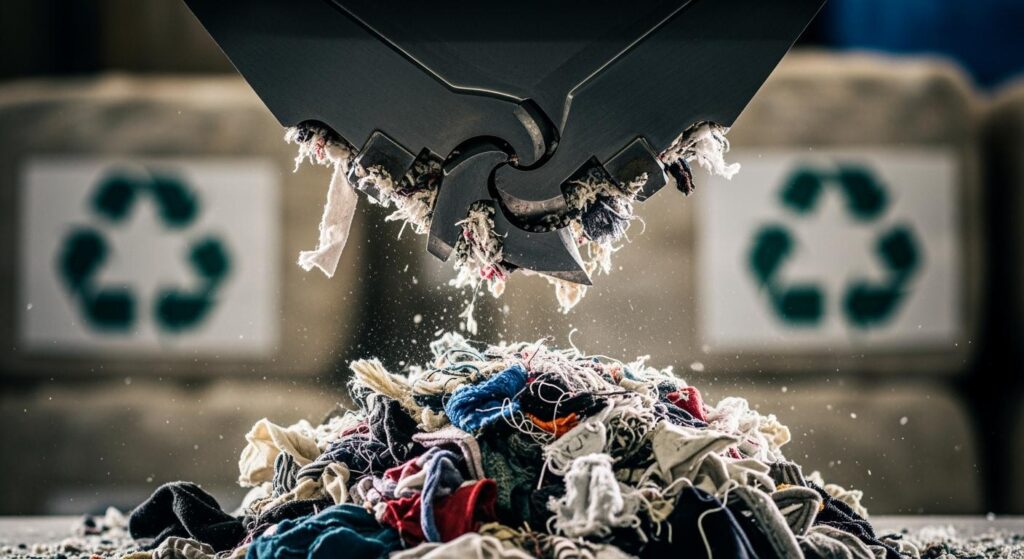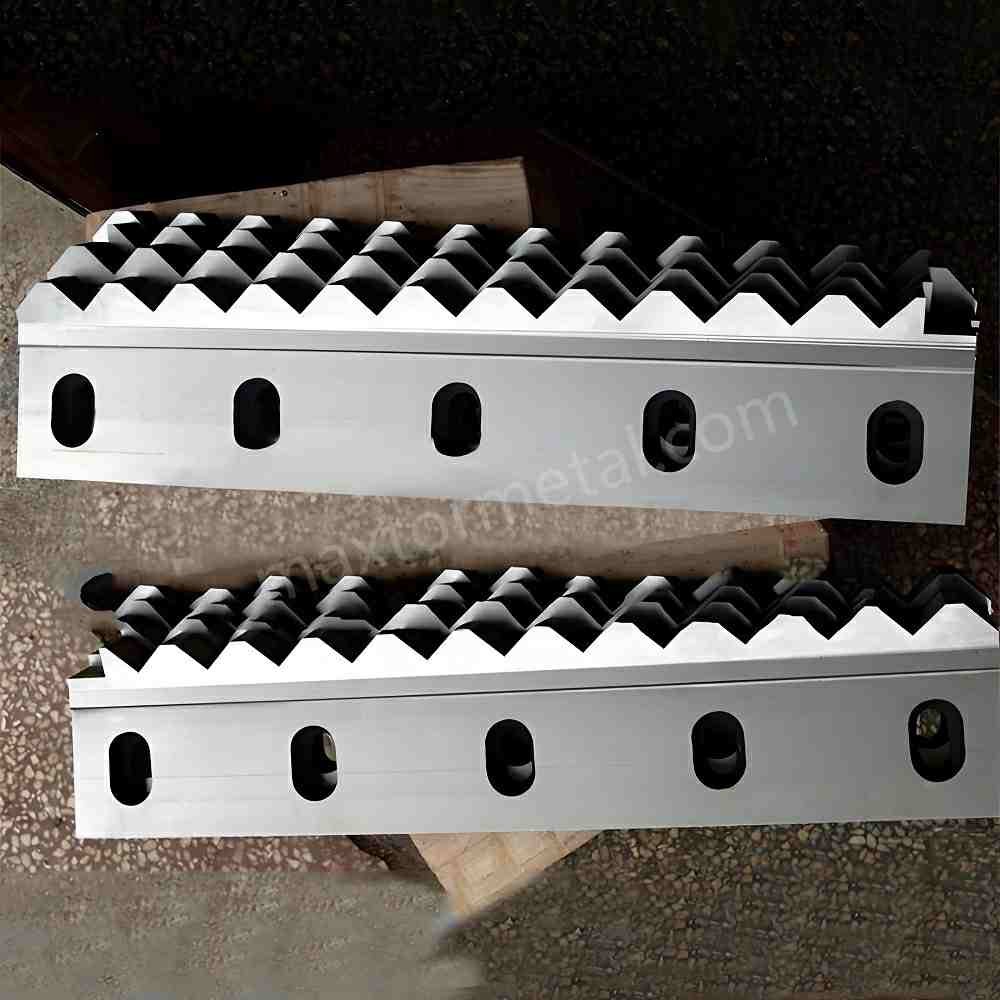
Lame per trituratori tessili Sono molto importanti nel riciclaggio. Tagliano i tessuti di scarto in piccoli pezzi. Questo aiuta a recuperare le fibre dai vecchi vestiti. L'uso di queste lame aiuta a evitare che i rifiuti finiscano in discarica. Aiuta anche a creare nuovi oggetti dai vecchi tessuti. Lo sapevi? meno dello 0,5% di tutti i rifiuti tessili viene riciclato? La maggior parte dei tessuti usati finisce in discarica o viene bruciata. Le lame per la triturazione dei tessuti aiutano gli impianti di riciclaggio a lavorare con tessuti misti, aiutando a ricavare fibre utili da questi tessuti.
- Le lame dei trituratori tessili sminuzzano spessi cumuli di tessuti e tappeti.
- Queste lame riducono le dimensioni del materiale e facilitano la selezione per il riciclaggio.
| Funzione | Beneficio |
|---|---|
| Adattabilità | Gestisce diverse fibre |
| Elaborazione ad alta capacità | Funziona con grandi volumi |
| Efficienza energetica | Risparmia energia |
| Costruzione robusta | Funziona sempre |
Punti chiave
- Le lame dei trituratori tessili sono molto importanti per il riciclo. Tagliano i vecchi tessuti in piccoli pezzi, facilitando il recupero di fibre utili.
- Utilizzare le lame giuste per ogni tessuto aiuta a triturare meglio, riducendo gli sprechi e migliorando la qualità dei materiali riciclati.
- Prendersi cura delle lame del trituratore è molto importante. Pulirle, affilarle e controllare che siano allineate. Questo le aiuterà a funzionare bene e a durare più a lungo.
- Le lame personalizzate possono migliorare il riciclaggio. Sono realizzate per materiali specifici. Questo garantisce risultati migliori e consente di risparmiare denaro.
- L'acquisto di nuove tecnologie di triturazione aiuta a velocizzare il processo di riciclo. Nuove idee come l'intelligenza artificiale e i sistemi intelligenti contribuiscono a far funzionare le cose al meglio.
Lame per trituratori tessili nel riciclaggio

Scomposizione dei tessuti
Per riciclare i tessuti servono strumenti robusti. Le lame per triturare i tessuti sono molto importanti per questo lavoro. Queste lame tagliano e strappano i tessuti in piccoli pezzi. Questo rende più facili da spostare e gestire grandi cumuli di rifiuti tessili. Diversi tessuti possono essere difficili da tagliareMateriali morbidi come cotone, lana e poliestere sono facili da sminuzzare perché si piegano. Tessuti resistenti come denim e pelle necessitano di macchine distruggidocumenti più performanti. I tessuti misti, invece, sono composti da fibre diverse e sono più difficili da sminuzzare. Per funzionare al meglio, è necessario impostare la macchina in modo specifico.
Le lame dei trituratori tessili sono progettate per materiali fibrosi. I loro bordi affilati aiutano a tagliare indumenti spessi, tappeti e tessuti sintetici resistenti. Le lame giuste rendono le fibre uniformi e soffici. Fibre uniformi sono necessarie per le successive fasi di riciclaggio.
Suggerimento: scegli la lama giusta per ogni tessuto. Questo aiuta la macchina a lavorare meglio ed evita inceppamenti.
Nanjing Metal Industriale produce lame che aiutano a risolvere questi problemi. Le loro lame hanno bordi dentati per un taglio migliore. Le lame sono spesse, da 10 mm a 50 mm, in modo da poter sopportare colpi violenti. Il design robusto della radice le rende più durevoli. Rivestimenti speciali proteggono le lame dall'acqua. Se hai bisogno di una lama speciale, controlla il loro pagina delle lame personalizzate per avere più scelte.
Abilitazione del recupero della fibra
Dopo la triturazione, il passaggio successivo è l'estrazione delle fibre. Le lame dei trituratori tessili aiutano a separare le fibre principali dalle cuciture e da altre parti. Questo consente di ottenere materiali utili come cotone e poliestere.
Diversi trituratori sono più adatti a scopi diversi. Ecco una tabella che mostra come ogni trituratore aiuta a estrarre le fibre:
| Tipo di trituratore | Descrizione | Applicazione |
|---|---|---|
| Monoalbero | Ha un rotore veloce con molte lame e un coltello fisso. | Ideale per oggetti leggeri come i vestiti. |
| Doppio albero | Ha due alberi rotanti con dischi affilati. | Adatto a materiali spessi e resistenti. |
| Trituratore di fibre | Separa il tessuto per mantenere lunghe le fibre. | Ottimo per realizzare filati da fibre vecchie. |
I trituratori di fibre possono trasformare il tessuto in fibre in 90 secondiMantengono le fibre lunghe, il che è utile per la produzione di filati. Le fibre lunghe consentono di realizzare nuovi prodotti migliori.
È possibile affilare nuovamente queste lame, risparmiando denaro e prolungandone l'utilizzo. Se hai bisogno di qualcosa di speciale, il nostro team può aiutarti a realizzare una lama su misura per te.
Le lame dei trituratori tessili aiutano a trasformare i rifiuti in oggetti utili. Con le lame e le impostazioni giuste, è possibile triturare molti tessuti e ottenere fibre di qualità per nuovi prodotti.
Vantaggi per gli impianti di riciclaggio

Efficienza e coerenza
Vuoi che il tuo impianto di riciclaggio funzioni bene ogni giorno? Le lame per trituratori tessili contribuiscono a raggiungere questo obiettivo. Queste lame utilizzano motori potenti e leghe resistenti. Ciò significa che consumano meno energia e costano meno in termini di gestione. Il design a doppio asse distribuisce la forza in modo uniforme. Questo aiuta le macchine a durare più a lungo e a rimanere stabili. Puoi vedere queste caratteristiche nella tabella seguente:
| Caratteristica | Beneficio |
|---|---|
| Motori avanzati a risparmio energetico | Consuma meno energia, quindi costa meno da gestire. |
| Lame in lega ad alta resistenza | Rimane affilato e resistente, quindi taglia bene e impedisce la formazione di grovigli. |
| Design a doppio asse | Condivide la forza, mantiene la macchina stabile e ne aumenta la durata. |
Puoi triturare materiali resistenti come gli scarti di spandex senza rallentare. Questo consente al tuo impianto di continuare a lavorare a piena velocità.
Qualità del materiale
Per i nuovi prodotti, è necessario utilizzare fibre riciclate di buona qualità. Le lame dei trituratori tessili aiutano a ottenere pezzi di tessuto più piccoli e uniformi. Questo rende il materiale riciclato più adatto a prodotti come isolanti o riempitivi. Il design a doppio albero è utile anche per i rifiuti tessili più duri. I vantaggi sono visibili in questa tabella:
| Vantaggio | Descrizione |
|---|---|
| Capacità di elaborazione efficiente | Il design a doppio albero aiuta a triturare bene anche i rifiuti tessili più resistenti. |
| Effetto di frantumazione fine | Il design della lama crea pezzi piccoli e uniformi, quindi è più facile riciclarli. |
Riduci anche gli sprechi fino al 70%. Questo aiuta a proteggere il tuo marchio distruggendo i prodotti scadenti.
Impatto sulla sostenibilità
Aiutate il pianeta utilizzando buone lame per trituratori tessili. Queste lame consentono di risparmiare energia e ridurre l'inquinamento. Triturare correttamente significa che meno rifiuti finiscono in discarica. Nei test, le lame che triturano rifiuti misti hanno ridotto i rifiuti in discarica di 35%. È possibile recuperare fino a 95% di materiali da vecchi articoli. Lame per trituratori in macchine come il Fiberizer trasformare i vecchi vestiti in fibraPuoi usare questa fibra per creare nuovi oggetti. Questo evita che i rifiuti finiscano nelle discariche e aiuta a chiudere il ciclo del riciclo.
Fattori di prestazione

Materiale e design della lama
Le lame devono essere resistenti per tagliare molti tipi di tessuti. Le lame dei trituratori tessili devono essere in grado di gestire tutti i tipi di fibre. A volte, il tessuto presenta cerniere e bottoni. Queste parti rendono la triturazione più difficoltosa per le lame. Le lame realizzate in metallo D2 e SKD11 sono adatte. Questi metalli contribuiscono a una maggiore durata delle lame e a un taglio migliore. Il taglio laser e i trattamenti termici rendono le lame ancora più resistenti. Le lame piatte con bordi affilati tagliano meglio i tessuti spessi.
Suggerimento: le lame personalizzate possono durare la metà del tempo rispetto alle lame normali. Questo ti aiuta a risparmiare denaro e a ottenere risultati migliori.
Esigenze di manutenzione
Vuoi che le tue lame funzionino bene ogni giorno. Pulirle le mantiene libere da sporco e fibre. La lubrificazione aiuta le parti mobili a funzionare senza intoppi. Dovresti controllare spesso le lame per affilarle o sostituirle. Assicurati che siano allineate in modo che non si urtino tra loro. Una buona manutenzione aiuta le lame a durare più a lungo e mantiene la macchina sicura.
- Pulire le lame per eliminare lo sporco.
- Lubrificare le parti mobili per evitare attriti.
- Controllare l'usura delle lame per affilarle o sostituirle.
- Controllare l'allineamento per evitare danni.
Opzioni di personalizzazione
Puoi scegliere tra numerose caratteristiche per le lame del tuo trituratore. La personalizzazione ti aiuta a ottenere i migliori risultati per la tua pianta. Puoi modificare la configurazione delle lame, le dimensioni di triturazione e la potenza del motore. Puoi anche scegliere la dimensione di taglio desiderata. Alcuni trituratori ti permettono di personalizzarli in base alle tue esigenze.
| Aspetto di personalizzazione | Dettagli |
|---|---|
| Configurazioni delle lame | Può essere modificato per lavori diversi. |
| Dimensioni di triturazione | Può essere impostato in base al tipo e alla quantità di rifiuti di plastica. |
| Specifiche del motore | Diverse opzioni per soddisfare le tue esigenze. |
| Dimensioni di taglio regolabili | Ti consente di scegliere la dimensione desiderata per l'output. |
| Gamma di potenza del motore | Varia da 5 CV a 100 CV per diversi lavori. |
| Progettazione personalizzata | I distruggidocumenti possono essere realizzati in base alle vostre specifiche esigenze. |
Le lame personalizzate funzionano meglio e ti fanno risparmiare denaro nel tempo. Riceverai lame adatte alle tue esigenze e che durano più a lungo delle lame tradizionali.
Sfide e soluzioni

Usura e danni alla lama
Le lame dei trituratori tessili nel settore del riciclaggio presentano molti problemi. Dopo un po' di tempo, possono smussarsi o rompersi. È fondamentale mantenere le lame in buone condizioni per ottenere risultati ottimali. Ecco alcuni esempi. semplici modi per far durare più a lungo le lame:
- Ispezione e pulizia regolari: Controlla spesso le lame per verificare che non siano danneggiate. Puliscile da sporco e fibre.
- Tecniche di affilatura corrette: Affilare le lame quando diventano smussate. Mantenere lo stesso angolo di taglio per un lavoro di qualità.
- Installazione e allineamento corretti della lama: Assicurarsi che le lame siano ben strette e allineate. Questo evita un'usura irregolare.
- Lubrificazione e protezione dalla corrosione: Lubrificare le parti mobili e proteggere le lame dalla ruggine.
- Conservazione corretta quando non in uso: Riporre le lame in un luogo asciutto. Utilizzare olio per prevenire la ruggine.
Suggerimento: eseguire queste operazioni ogni mese aiuta a far durare più a lungo le lame del trituratore di tessuti durante il riciclaggio.
Gestione di materiali misti
Nel riciclaggio tessile si lavora spesso con tessuti misti. Tessuti misti come poliestere e cotone sono difficili da trattare con le lame dei trituratori tessili. Alcuni metodi di riciclaggio funzionano meglio di altri. La tabella seguente mostra come ogni metodo gestisce i tessuti misti:
| Metodo di riciclaggio | Idoneità per tessuti misti | Sfide |
|---|---|---|
| Riciclaggio meccanico | Non adatto | I tessuti misti producono fibre deboli e prodotti di scarso valore. |
| Complessità dei materiali | Impedisce il riciclaggio | Le tinture e le finiture rendono più difficile il riciclaggio e limitano la presenza di poliestere negli scarti di cotone. |
- Gli scarti tessili misti costituiscono una parte importante dei rifiuti tessili mondiali.
- Molti tessuti misti finiscono nelle discariche perché il riciclaggio non è avanzato.
- Le miscele di poliestere/cotone sono più facili da riciclare, ma altre miscele sono comunque resistenti.
Prolungamento della durata della lama
Vuoi che le lame del tuo trituratore di tessuti durino più a lungo? Puoi fare semplici cose per aiutarti. Pulisci le lame dopo l'uso. Affila le lame prima che diventino troppo smussate. Conserva le lame in un luogo asciutto e usa dell'olio per prevenire la ruggine. Controlla che le lame siano allineate per evitare danni. Usa la lama giusta per ogni tipo di tessuto. Questi passaggi ti aiutano a risparmiare denaro e a far sì che il riciclaggio funzioni bene.
Nota: prendersi cura delle lame del trituratore tessile durante il riciclaggio e controllarle spesso aiuta a farle funzionare al meglio.
Tendenze future

Innovazione nella tecnologia delle lame
Grandi cambiamenti sono in arrivo per le lame dei trituratori tessili nel settore del riciclo. Le nuove macchine ora sono in grado di gestire molto meglio i tessuti misti. L'automazione e l'intelligenza artificiale aiutano queste macchine a lavorare in modo più rapido e intelligente. Il riciclo chimico consente di riciclare più tipi di fibre sintetiche. Queste nuove idee rendono il riciclo più semplice ed efficiente.
- Le macchine lavorano più velocemente con i tessuti misti.
- L'automazione e l'intelligenza artificiale aiutano a risparmiare tempo e fatica.
- Il riciclaggio chimico consente di riciclare più fibre sintetiche.
Monitoraggio intelligente
I sistemi di monitoraggio intelligenti aiutano a mantenere Le lame dei trituratori tessili nel settore del riciclaggio funzionano bene. Questi sistemi monitorano parametri come il carico del motore, la temperatura e la quantità di materiale processato. Si ricevono avvisi quando è necessario sostituire dei componenti, in modo da evitare guasti. Gli operatori possono controllare il funzionamento delle macchine da qualsiasi luogo tramite connessioni remote. I dashboard intelligenti mostrano come tutto funziona.
| Caratteristica | Descrizione |
|---|---|
| Monitoraggio in tempo reale | Controlla costantemente il carico del motore, la temperatura e la velocità di avanzamento del materiale. |
| Manutenzione predittiva | Utilizza i dati per individuare tempestivamente i problemi e pianificare le riparazioni prima che si rompano. |
| Monitoraggio remoto | Consente di controllare e controllare le macchine da qualsiasi luogo con accesso sicuro. |
- I sistemi di controllo intelligenti modificano autonomamente le impostazioni.
- I dashboard mostrano dati chiari per scelte rapide.
Prospettive del settore
Si assisterà a una forte crescita delle lame per trituratori tessili nel settore del riciclaggio. Il mercato mondiale del riciclaggio tessile ha raggiunto $6 miliardi nel 2024Gli esperti pensano che crescerà di oltre 4,9% ogni anno fino al 2034. Nuove tecnologie come Analisi AI e sensori IoT ti aiuterà a ottenere risultati migliori e una maggiore durata della lama. Saranno utilizzati di più materiali ecocompatibili e centri di riciclaggio locali. Norme più severe e persone che desiderano soluzioni ecologiche spingeranno le aziende a utilizzare sistemi di triturazione migliori.
- I sensori AI e IoT aiutano le lame a funzionare meglio e a evitare i tempi di inattività.
- Le lame ecologiche e i centri di riciclaggio contribuiscono alla crescita del riciclaggio.
- L'area Asia-Pacifico e altre aree utilizzeranno più rapidamente le nuove tecnologie di riciclaggio.
Nota: conoscere le nuove tecnologie e i sistemi intelligenti ti aiuterà a sfruttare al meglio le lame dei trituratori tessili nel riciclaggio.
Scegliendo le lame giuste per il trituratore tessile, contribuisci al riciclo. Queste lame ti permettono di recuperare le fibre e di evitare che i rifiuti finiscano in discarica. Le lame più recenti velocizzano il riciclo e producono materiali riciclati di migliore qualità.
- È possibile lavorare facilmente con molti tipi di tessuti.
- Si ottengono prodotti riciclati più puliti e di migliore qualità.
| Caso di studio | Descrizione | Risultato |
|---|---|---|
| Riciclatore europeo | Ho provato le macchine SSI | 30% più lavoro svolto, meno tempo di arresto |
| produttore asiatico | Trituratori Weima usati | Utilizza meno energia, rende il lavoro più sicuro |
| azienda nordamericana | Ho guardato diversi modelli | Scegli un design modulare per un facile fissaggio |
Puoi migliorare il funzionamento del tuo impianto con soluzioni personalizzate. Per maggiori informazioni, contatta un tecnico commerciale. Qui.
Domande frequenti
Cosa sono le lame per trituratori tessili nel riciclaggio?
Le lame dei trituratori tessili utilizzati nel riciclaggio tagliano i vecchi tessuti in piccoli pezzi. Queste lame aiutano a sminuzzare oggetti come vestiti e tappeti. Tagliare i tessuti facilita il recupero delle fibre per nuovi prodotti.
Come scegliere le lame giuste per il trituratore tessile nel riciclaggio?
Devi sapere che tipo di tessuto vuoi triturare. Per i materiali più resistenti servono lame più potenti. Per i tessuti più morbidi puoi usare lame normali. Le lame personalizzate sono adatte ai tessuti misti e aiutano a estrarre più fibre.
Con quale frequenza è necessario sottoporre a manutenzione le lame del trituratore tessile durante il riciclaggio?
Controllare e pulire le lame una volta a settimana. Affilarle se perdono il filo. Prendersi cura delle lame aiuta a prevenire problemi alla macchina e a mantenere il riciclaggio efficiente.
Le lame dei trituratori tessili utilizzati nel riciclaggio possono gestire materiali misti?
Sì, le lame per trituratori tessili nel settore del riciclaggio possono tagliare tessuti misti. Sono adatte a cotone, poliestere, denim e altri tessuti misti. I risultati migliori si ottengono utilizzando la lama giusta per ogni tessuto.
Perché le lame degli impianti di triturazione tessile sono importanti per la sostenibilità nel riciclaggio?
L'utilizzo di lame per trituratori tessili nel riciclaggio contribuisce a ridurre i rifiuti conferiti in discarica. Queste lame consentono di recuperare le fibre e riutilizzare i materiali, contribuendo a mantenere il pianeta più pulito e a risparmiare risorse.
Vedi anche
Perché le Lame per Trituratori Personalizzate Sono un Investimento Intelligente per la Tua Attività
Suggerimenti per la manutenzione della lama perforante per massimizzarne la durata e l'affilatura



2 risposte
Scritto alla perfezione. Né troppo semplice, né troppo complesso.
Grazie